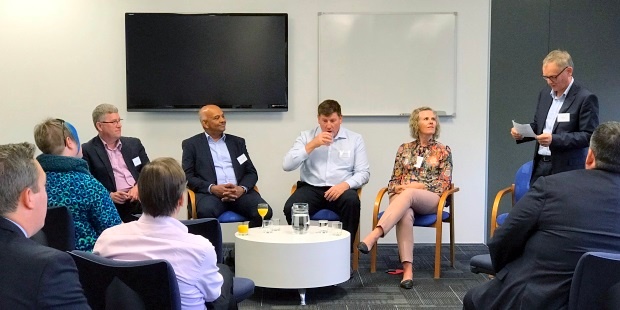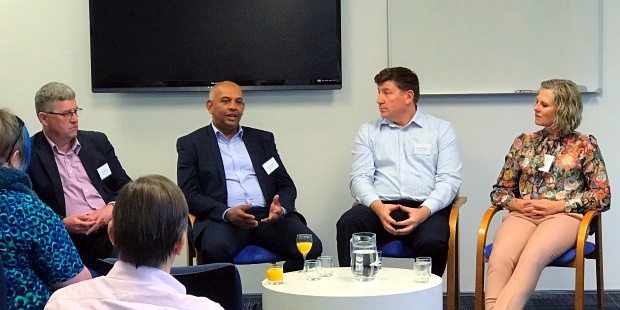Share this
The changing CIO role - an Equinox IT hosted CIO panel discussion
by Bill Ross on 20 April 2018

IT and the CIO role is changing significantly. New technologies, different operating models and modern experiences and expectations are changing the landscape and the CIO role is constantly evolving to meet the new reality.
To understand more about the changing CIO role, on Wednesday evening we hosted a CIO panel event involving four Wellington-based CIOs:
- Chris Buxton, Chief Digital Officer, Statistics New Zealand - providing a central government perspective
- Channa Jayasinha, Chief Information Officer, Wellington City Council - providing a local government perspective
- Richard Ashworth, Chief Technology and Innovation Officer, Royal New Zealand Plunket Society - providing a not-for-profit perspective
- Dianna Taylor, Chief Information Officer, New Zealand Racing Board - providing a private sector perspective.
I facilitated the panel - Bill Ross, Equinox IT Principal Consultant.
The discussion was wide ranging and included excellent questions from attendees, which the panellists answered very well. From chatting with both panellists and attendees after the formal part of the event everyone seemed to have enjoyed the evening and found it very informative. Equinox IT runs regular executive events and will look to hold more panel sessions similar to this one again in the future.
This post summarises the discussion. I have not attributed comments to the panel members, but instead looked to summarise the key discussion points made across the panel.

Biggest changes in IT
- Broadening of influence - technology decisions not solely controlled by IT anymore - the business is more engaged in technology decision making
- Expectation that digital and technology change is delivered rapidly, sometimes with little understanding of the complexity required to do so
- The proliferation of information and limited time to consume it - it is not easy to know what the important things are.
IT team composition and skills with 'as a service'
- Traditional IT roles no longer the right fit for today's IT needs
- Need for better problem solving skills and system integration skills
- Greater need for commercial acumen to maximise opportunities and work with service providers to deliver results
- Move to digital services teams that deliver digital change to the organisation
- In many organisations technology and network roles have disappeared, as technology and networks are outsourced to managed service providers and 'as a service' providers
- Greater focus on business involvement in IT projects - introduction of business roles to act as the businesses owner and business decision maker on IT projects.

Financing IT
- 'As a service' drives an operating expenditure model (opex) rather than a capital expenditure model (capex)
- Government's way of working focuses on capex and CFOs are generally reluctant to give CIOs a significant opex budget, which leads government IT teams to face budget challenges when using modern IT models
- Consumption services can rapidly use up budget if not manged
- Transitioning from capex to opex presents challenges with IT still incurring depreciation on capital investments while in parallel increasing operating costs
- Discussion required with CFO to learn to work together and to help them understand the need to move from capex to opex.
Business-led change
- Everybody is a technologist now, and managing the technology decisions made across different parts of the organisation is not just a CIO challenge, it is also an organisational challenge
- The business is much more aware of technology disruption and has better insight into customer behaviour, leading to richer conversations between business and IT
- Sometimes it requires letting the business make their own decisions for now, with the expectation that longer term it will come back to IT to ensure security, data sovereignty, cost and other standards are adequately considered
- IT needs to ensure that what it offers is better than what is on offer elsewhere - if the business can source it cheaper elsewhere, then IT should consider going elsewhere directly
- Some discussion and education is required - what might be seen as lower cost is often not so when you look at the total cost of ownership and consider factors such as risks to security, data loss and so forth
- Acceptance that IT no longer 'controls everything', there is a need to trust people to do the right thing and also a need to monitor
- IT needs to encourage the business to partner, the business owns the benefits, IT helps make it happen, the business can't simply leave IT to it and then blame IT.

Configuration vs customisation
- There is a clear move to configuration of products rather than custom development - "why wouldn't you use something that already works rather than develop it from scratch"
- At some organisations customisation is no longer an option - decision has been made to use products and configure to business needs
- A number of the panel members spoke about customised legacy systems that are now difficult and costly to upgrade
- A need to manage expectations better - business analysts ask the business what they want and it creates an expectation that the business can have what they want at any cost.
Security
- Many 'as a service' products today, such as Azure and Salesforce, have superior security to what the organisation can provide itself
- The biggest risk is 'end user computing' and so there is a need for communication and education around the risks of phishing, ransomware and other end user threats
- Need for business continuity planning, including how the business would continue if its technology was taken down by a security threat
- Managing the risks associated with disclosing sensitive personal information is always a priority.

Strategy and organisational relevance
- The days of five-year roadmaps are gone, they cost a lot to prepare and never line up with the changes that occur
- There is a shift more to principles, such as 'cloud first' or 'configuration over customisation' - strategy is now about the 'how' and not the 'what'
- CIO plays a greater role in ensuring organisations remain relevant - delivering services through digital channels seen as essential for organisational relevance - it can both help reduce cost and increase convenience / competitiveness
- 'As a service' models make the CIO role different - part of this is the greater focus on relationships and a collective 'make it work' attitude with service providers
- Metrics of running IT are changing - uptime is almost guaranteed with 'as a service', so almost not worth measuring it.
Clearly, the CIO role today has changed a great deal from what it used to be. We hope that this summary of the panel discussion provides insight into the changes taking place and provides value for changes that you are making to IT in your organisation.
Thank you Chris, Channa, Richard and Dianna for making the time to participate in our panel discussion. I know you all have very busy roles and a lot expected of you, so we're grateful to have had you involved in this event.
Share this
- Agile Development (153)
- Software Development (126)
- Agile (76)
- Scrum (66)
- Application Lifecycle Management (50)
- Capability Development (47)
- Business Analysis (46)
- DevOps (43)
- IT Professional (42)
- Equinox IT News (41)
- Agile Transformation (38)
- IT Consulting (38)
- Knowledge Sharing (36)
- Lean Software Development (35)
- Requirements (35)
- Strategic Planning (35)
- Solution Architecture (34)
- Digital Disruption (32)
- IT Project (31)
- International Leaders (31)
- Digital Transformation (26)
- Project Management (26)
- Cloud (25)
- Azure DevOps (23)
- Coaching (23)
- IT Governance (23)
- System Performance (23)
- Change Management (20)
- Innovation (20)
- MIT Sloan CISR (15)
- Client Briefing Events (13)
- Architecture (12)
- Working from Home (12)
- IT Services (10)
- Data Visualisation (9)
- Kanban (9)
- People (9)
- Business Architecture (8)
- Communities of Practice (8)
- Continuous Integration (7)
- Business Case (4)
- Enterprise Analysis (4)
- Angular UIs (3)
- Business Rules (3)
- Java Development (3)
- Lean Startup (3)
- Satir Change Model (3)
- API (2)
- Automation (2)
- GitHub (2)
- Scaling (2)
- Toggles (2)
- .Net Core (1)
- Diversity (1)
- Security (1)
- Testing (1)
- February 2024 (3)
- January 2024 (1)
- September 2023 (2)
- July 2023 (3)
- August 2022 (4)
- August 2021 (1)
- July 2021 (1)
- June 2021 (1)
- May 2021 (1)
- March 2021 (1)
- February 2021 (2)
- November 2020 (2)
- September 2020 (1)
- July 2020 (1)
- June 2020 (3)
- May 2020 (3)
- April 2020 (2)
- March 2020 (8)
- February 2020 (1)
- November 2019 (1)
- August 2019 (1)
- July 2019 (2)
- June 2019 (2)
- April 2019 (3)
- March 2019 (2)
- February 2019 (1)
- December 2018 (3)
- November 2018 (3)
- October 2018 (3)
- September 2018 (1)
- August 2018 (4)
- July 2018 (5)
- June 2018 (1)
- May 2018 (1)
- April 2018 (5)
- March 2018 (3)
- February 2018 (2)
- January 2018 (2)
- December 2017 (2)
- November 2017 (3)
- October 2017 (4)
- September 2017 (5)
- August 2017 (3)
- July 2017 (3)
- June 2017 (1)
- May 2017 (1)
- March 2017 (1)
- February 2017 (3)
- January 2017 (1)
- November 2016 (1)
- October 2016 (6)
- September 2016 (1)
- August 2016 (5)
- July 2016 (3)
- June 2016 (4)
- May 2016 (7)
- April 2016 (13)
- March 2016 (8)
- February 2016 (8)
- January 2016 (7)
- December 2015 (9)
- November 2015 (12)
- October 2015 (4)
- September 2015 (2)
- August 2015 (3)
- July 2015 (8)
- June 2015 (7)
- April 2015 (2)
- March 2015 (3)
- February 2015 (2)
- December 2014 (4)
- September 2014 (2)
- July 2014 (1)
- June 2014 (2)
- May 2014 (9)
- April 2014 (1)
- March 2014 (2)
- February 2014 (2)
- December 2013 (1)
- November 2013 (2)
- October 2013 (3)
- September 2013 (2)
- August 2013 (6)
- July 2013 (2)
- June 2013 (1)
- May 2013 (4)
- April 2013 (5)
- March 2013 (2)
- February 2013 (2)
- January 2013 (2)
- December 2012 (1)
- November 2012 (1)
- October 2012 (2)
- September 2012 (3)
- August 2012 (3)
- July 2012 (3)
- June 2012 (1)
- May 2012 (1)
- April 2012 (1)
- February 2012 (1)
- December 2011 (4)
- November 2011 (2)
- October 2011 (2)
- September 2011 (4)
- August 2011 (2)
- July 2011 (3)
- June 2011 (4)
- May 2011 (2)
- April 2011 (2)
- March 2011 (3)
- February 2011 (1)
- January 2011 (4)
- December 2010 (2)
- November 2010 (3)
- October 2010 (1)
- September 2010 (1)
- May 2010 (1)
- February 2010 (1)
- July 2009 (1)
- April 2009 (1)
- October 2008 (1)